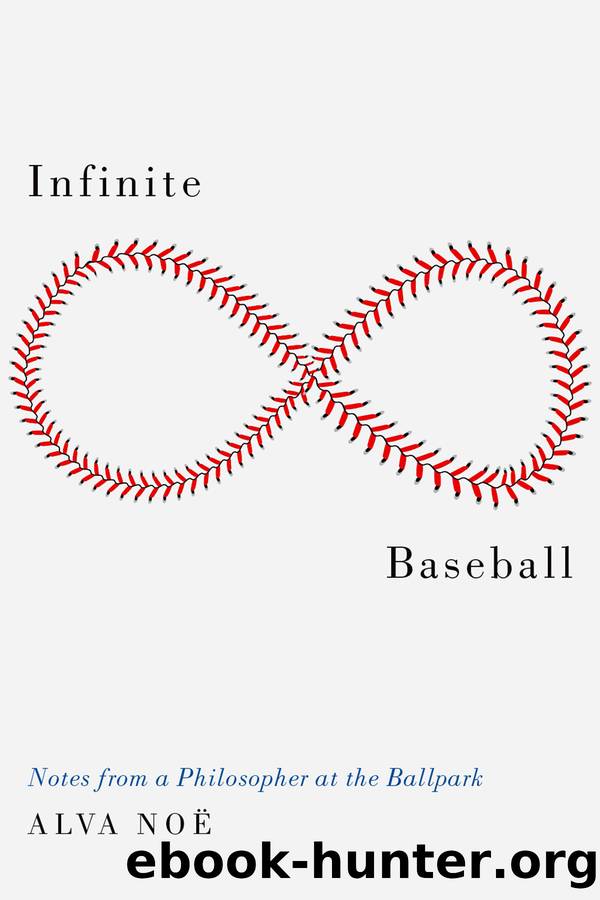Infinite Baseball by Alva Noë

Author:Alva Noë [Noë, Alva]
Language: eng
Format: epub
Published: 2019-06-15T00:00:00+00:00
* * *
1 See Janet L. Starkes and K. Anders Ericsson, Expert Performance in Sports: Advances in Research on Sports Expertise (Windsor, Ontario: Human Kinetics, 2003).
2 William Chase and Herbert Simon, âPerception in Chess,â Cognitive Psychology (1973): 55â81.
3 For a nice discussion of the case of Jennie Finch, see David Epsteinâs The Sports Gene: Inside the Science of Extraordinary Athletic Performance (New York: Current/Penguin Group, 2014).
14
Nobodyâs Perfect
In the baseball world, there are two distinct theories of umpiring.
Some view umpires as, in essence, instruments, somewhat outdated, for measuring baseball facts. From this standpoint, every âbad callâ is an occasion to demand improvements in measurement technology. Umpires call them as they see them, but they donât see any better than the rest of us. They should be eliminated by, or at least supplemented with, instant replay and other new measuring devices.
Others, however, think of umpires as, in effect, a special class of player in the game; they are no less a part of the game than the players themselves. From this standpoint, the demand that we replace umpires with machines has about as much to recommend it as the idea that one might remove or replace the players themselves to improve the game. Itâs an idiotic idea.
These two distinct ideas about umpiring correspond to what are really distinct philosophies of the game. Corresponding to the umpire-as-instrument idea is Realism. According to Realism, there are umpiring-independent facts of the gameâballs really are fair or foul, runners are either safe or outâand the questions we face are merely epistemological: how best to determine the facts, how to find out.
Corresponding to the umpire-as-player idea is Anti-Realism. According to Anti-Realism, umpires donât call them as they see them; umpires, through their calls, make it the case that a pitch is a strike or a ball, a runner is safe or out. There are no umpire-independent facts in baseball.
Realism does a good job accounting for the apparent fact that there are âbad callsâ and also the fact that dispute and controversy seem to be ever-present parts of the game. After all, it is facts of the matter about, say, whether someone is safe or out, that grounds the possibility that umpires can be mistaken. Anti-Realism, for its part, is helpless to make sense of this. If what an umpire says goes, then how can we even take seriously the idea that an umpire might be mistaken?
But Anti-Realism gets something right, too. Baseball facts are not like facts of physics. Consider: what interests us in baseball is whether players succeed or fail, whether they achieve or get lucky. The judgment that a ball is a strike is, from the Anti-Realist standpoint, the judgment that a pitcher delivered a pitch that the batter ought to have hit. This is not so much a judgment about where the pitch was located as it is a judgment about whether the pitcher or the batter deserves credit. It is, in the original sense of the term, and as I have already explained, a forensic judgment.
Download
This site does not store any files on its server. We only index and link to content provided by other sites. Please contact the content providers to delete copyright contents if any and email us, we'll remove relevant links or contents immediately.
Big Boys' Rules by Mark Urban(491)
Resistance band Training: A Resistance Bands Book For Exercise At Home Or On The Go. by Atkinson James(455)
Saving the World and Other Extreme Sports: A Maximum Ride Novel by James Patterson(447)
Training for the New Alpinism by Steve House Scott Johnston Mark Twight(406)
Idiot's Guides - Krav Maga by Kevin Lewis & David Michael Gilbertson(383)
To Hell and Back by Niki Lauda(343)
The College Football Problem by Rick Telander(334)
Woodlawn by Todd Gerelds(322)
The Science of Car Racing (The Science of Speed) by Karen Latchana Kenney(315)
Sports Biomechanics by Blazevich Anthony(310)
Survival by Navy Seal Workout(308)
The Goalkeeper's History of Britain (text only) by Peter Chapman(307)
The Cleveland Way by Alan Staniforth(278)
THE HISTORY OF FORMULA 1 TO THE RHYTHM OF FAST LAP: 1950-2020 Travel back in time with Ferrari, Fangio, Williams, Prost, Senna, McLaren, Alonso, Mercedes... by Charles Sanz(272)
American Krav Maga by Mark Slane(272)
Open Net by George Plimpton(272)
Take Your Eye Off the Ball 2.0: How to Watch Football by Knowing Where to Look by Pat Kirwan & David Seigerman(270)
Hadaka-Jime: The Core Technique for Practical Unarmed Combat by Moshe Feldenkrais(263)
Separate Games by David K. Wiggins(261)
